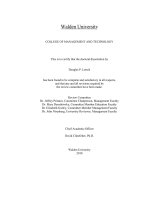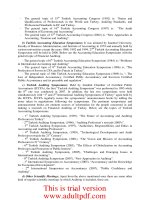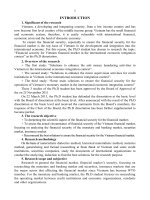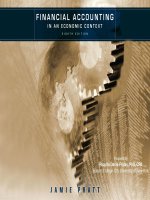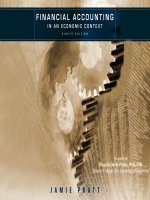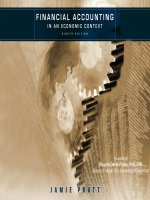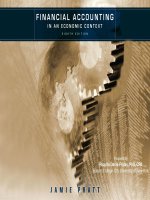Financial accounting in an economic context 8e chapter 014
Bạn đang xem bản rút gọn của tài liệu. Xem và tải ngay bản đầy đủ của tài liệu tại đây (1.4 MB, 46 trang )
1
Chapter 14
Statement of Cash Flows
2
Figure 14-1
3
Definition of Cash
Cash
consists of coin, currency, and available funds on
deposit at the bank. Negotiable instruments such as
money orders, certified checks, cashier’s checks, personal
checks, and bank drafts are also considered cash .
Also
certain cash equivalents, which include commercial
paper and other debt investments with maturities of less
than three months are included in the statement of cash
flows.
4
Standard Statement of Cash Flows
5
Statement of Cash Flows
Required for financial statements by SFAS 95
(1987).
Primary purpose is to provide relevant
information about cash receipts and cash
disbursements of the company during the
period.
Serves to complement the other financial
statements.
Focus is on cash flows, not income.
Reconciles the balance sheet and the income
statement.
6
Content of Statement of Cash Flows
Explains change in cash and cash equivalents.
Cash equivalents are defined as short-term,
highly liquid investments near to maturity.
Examples of cash equivalents are Treasury bills
and money market funds.
Format of SCF includes the following three
sections:
- cash flow from operating activities.
- cash flow from investing activities.
- cash flow from financing activities.
Like US GAAP, IFRS requires the presentation
of a SCF, and the format is largely the same.
7
Cash Flows from Operating Activities
CF from operating activities is based on the
income statement, and converts income activity to
a cash basis.
There are two formats for the presentation of CF
from operating activity:
– direct method: this technique shows
cash received from customers and cash
paid to various entities for operating
activities.
– indirect method: this technique starts
with net income and makes adjustments
to net income to convert it to a cash
basis.
8
Cash Flows from Operating Activities
If the direct method is used, the indirect method
must be presented in a supplementary schedule.
The direct method is more informative, but the
vast majority of companies present only the
indirect method.
FASB is considering a change to require the direct
method.
9
Cash Flows from Investing Activities
CF from investing activities explain the changes in
cash from the purchase or sale of the company’s
(primarily) long-term assets.
Examples of investing activity includes:
– cash paid for purchase of equipment, land,
buildings, marketable securities (available-for-sale
and equity), intangible assets, and most other long
term assets.
– cash received from sale of equipment, land,
buildings, marketable securities (available-for-sale
and equity), intangible assets, and most other long
term assets.
– cash paid for issue of non-trade notes receivable
(both short-term and long-term).
– cash received for repayment on non-trade notes
receivable (both short-term and long-term).
10
Cash Flows from Investing Activities
General rule for investing activity:
– cash flows for purchase and sale of long-term assets.
Exceptions to the rule:
– Short term notes receivable (non-trade) are included in
the investing section.
– Long term notes receivable (trade) are not included in
the investing section. Because they relate to trade, they
are treated just like accounts receivable in the operating
section.
– The change in equity method investments is classified
in the operating section of SCF, because the change
deals with income. (Purchase and sale of equity
investments are classified in investing.)
Note: Trade receivables are created when inventory is sold
on account. Non-trade receivables are created when a
company loans cash to employees or others (no sale is
involved).
11
Cash Flows from Financing Activities
CF from financing activities explain the changes in
cash from the issue or retirement of the company’s
(primarily) long-term liabilities and equity.
Examples of financing activity includes:
– cash received from issue of bonds, mortgages
and other long-term debt,
– cash received from issue of common stock and
preferred stock,
– cash paid for the retirement of long-term debt,
– cash paid for the repurchase of treasury stock,
– cash paid for dividends,
– cash received for issue of non-trade notes
payable (both short-term and long-term), and
– cash paid for retirement or repayment on nontrade notes payable (both short-term and longterm).
12
Cash Flows from Financing Activities
Note that cash paid for dividends is
classified as a financing activity, but cash
paid for interest is classified as an operating
activity.
Note that cash received for dividends and
cash received for interest are both classified
as operating activities.
13
Cash Flows from Financing Activities
General rule for financing activity:
– cash flows for issue and retirement of long-term
liabilities and equity.
Exceptions to the rule:
– Short term notes payable (non-trade) are
included in the financing section. (Short term bank
notes are very common examples.)
– Long term notes payable (trade) are not included
in the financing section. Because they relate to
trade, they are treated just like accounts payable
in the operating section. (LT trade N/P are rare.)
Note: trade payables are created when inventory is
purchased on a note. Non-trade payables are
created when a company or borrows cash from a
bank or others (no inventory purchase is involved).
14
Cash Flows from Operations (Indirect Method)
To understand the adjustments to get from net income to
CF from operations, we will classify the adjustments into
3 categories:
(1) Items that affect income but not CFO
(noncash items).
(2) Double counted gains and losses.
(3) Changes in related (accrual basis) assets and
liabilities from:
(a) Revenues recognized before cash is received.
(b) Expenses recognized after cash is paid.
(c) Revenues recognized after cash is received.
(d) Expenses recognized before cash is paid.
Remember: net income includes many activities that are
noncash, or only partly cash.
15
Indirect Method - Noncash Items
Noncash activities include
-Depreciation expense. For example:
Depreciation Expense
xx
Accumulated Depreciation
xx
-Amortization expense on intangible assets such as
patents and goodwill.
Amortization Expense
xx
Goodwill
xx
-Bad debt expense on the estimation of uncollectibles:
Bad Debt Expense
xx
Allowance for Doubtful Accts.
xx
Since these expenses originally reduced net income, the
amount of these expenses would need to be added back to
net income to get to cash from operations.
16
Figure 14-3
17
Indirect Method - Noncash Items
Another noncash activity deals with the amortization of
premiums and discounts on bonds payable. These
amortizations affect interest expense but not cash.
There are two components to interest expense each
period: (1) the cash paid for interest expense, and (2)
the amortization of premiums or discounts (the
noncash portion).
To find the direction of the adjustment, isolate the
noncash component (for amortization) of the interest
expense entry:
Interest expense
xx
Discount on B/P
xx
or
Premium on B/P
xx
Interest expense
xx
18
Indirect Method - Double Counted Items
The double counted items come from gains and
losses on investing and financing activity.
For example, assume that land is sold for $10,000
cash, and the original cost was $9,000:
Cash
10,000
Land
9,000
Gain on Sale of Land
1,000
In this case, the $10,000 cash received would be
shown in Investing. However, if the gain is not
adjusted out of net income, we would be “double
counting” that effect.
19
Indirect Method - Double Counted Items
Therefore, any gains or losses from sale of
investing assets (equipment, land, buildings, AFS
and equity investments, intangibles). The
adjustment to reverse out the effects would be:
– add the amount of loss to net income.
– subtract the amount of the gain from net
income.
The same holds true for gains and losses from the
early extinguishment of debt (like the gains/losses
from the retirement of bonds).
– add the amount of loss to net income.
– subtract the amount of the gain from net
income.
20
Indirect Method Change in Related Assets and Liabilities
The third category examines the change in the
assets and liabilities that relate to the remaining
income statement items, after the items in (1) and
(2) have been removed.
The adjustment for the effect of these changes is to
effectively “squeeze” the income statement item
from the accrual basis of accounting to the cash
basis of accounting.
21
Indirect Method Change in Related Assets and Liabilities
For example, assume that total sales revenue
recognized for the year is $100,000. At the
beginning of the year, A/R were $2,000; at the end
of the year, A/R were $3,000.
What amount of cash was collected from
customers?
To analyze this effect, we must analyze the A/R
account, and how it is increased and decreased.
22
Indirect Method Change in Related Assets and Liabilities
Accounts Receivable
Beginning
Balance
Sales
Ending
Balance
Cash
Collection
on A/R
First assume that all
sales are on account.
Now note that the
relationship can be
expressed in a formula
involving A/R and
Sales:
A/RBeginning + Sales - Cash Collections = A/REnding
Or:
A/RBeginning + Sales - A/REnding = Cash Collections
23
Indirect Method Change in Related Assets and Liabilities
A/RB + Sales - A/RE = Cash Collections
2,000 + 100,000 - 3,000 = Cash Collections
99,000 = Cash Collections
Note that, to convert from accrual basis sales
revenues to cash basis sales revenues, an
increase in A/R should be subtracted from net
income to convert net income to a cash basis.
Correspondingly, a decrease in A/R should be
added to net income to convert net income to a
cash basis.
24
Indirect Method Change in Related Assets and Liabilities
This pair of rules can be expanded to a general set of
rules to convert NI from accrual to cash basis:
Subtract increases in related assets.
Add decreases in related assets.
Add increases in related liabilities.
Subtract decreases in related liabilities.
The types of assets that relate to the income statement are
primarily current assets, but not always. To decide, you must
look at each asset and its related income statement
component. Also, remember that we are looking at the
remaining assets and liabilities (after the eliminations in part
1). Since we have already eliminated depreciation expense
and amortization expense, etc., we would not include the
changes in these related assets (Accum. Depr., Patents, etc.).
25
